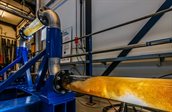Flow forcing
With our field experience and academic understanding, we work on the modelling and prediction of (multiphase) flow instabilities and multi-composition flow challenges. We design experimental setups in our lab to validate models of fluid-structure-interaction phenomena and verify solutions.

We assist our clients in evaluating and optimizing their design concerning the following subjects:
Screening for flow-induced pulsations/vibrations
In process installations where fluid flows with sufficient kinetic energy, flow induced forces can lead to integrity issues. Examples are pulsations and vibrations due to turbulence (FIT, Flow Induced Turbulence), vortex shedding at closed side branches (FIP, Flow Induced Pulsation), and multi-phase flow. A common method to evaluate the risk of integrity issues is described in the Energy Institute’s Guidelines for the Avoidance of Vibration Induced Fatigue Failure in Process Pipework / Subsea Systems (AVIFF).
Our 50 years of track record allow us to go beyond the results of the screening. We provide early warnings about the anticipated results and impact of follow-up specialist analyses, such that design changes can be implemented in time.
Flow induced pulsations and vibrations
Flow instabilities coupled to acoustic resonances in the pipe system can generate large amplitude pulsations – Flow-Induced Pulsations (FIP). By modelling the pipe system, the responses to FIP sources are calculated. If thresholds are exceeded, a mechanical response analysis is carried out to verify that limit levels of vibrations and cyclic stresses are not exceeded, and the integrity of your system is assured. In case of exceedings, we will always strive to eliminate the source of the vibrations: the pulsations. When this is not possible, additional or modified supporting structures can be recommended. We also measure mechanical natural frequencies in the field by hammer testing. If the natural frequencies show that the structure has sufficient stiffness, modelling and simulation of the piping with supports and beams may thus be avoided.

TNO will always look for a safe solution that is the most efficient and cost-effective for you.
Multiphase flow induced forces
We have been measuring and calculating forces induced by multiphase flows for over a decade at all scales relevant to different industries. Based on this, we characterize dynamic flow forces in systems subject to multiphase flows. We predict the mechanical responses of piping and supporting structures. Based on the calculated cyclic stresses, we make fatigue lifetime predictions. With this lifetime knowledge, the risk of failure and the costs of unnecessarily short maintenance intervals are avoided.

Process dynamics
TNO has a broad experience in pressure surge events and compressor surge analysis. A pressure surge event can be caused by the closure of a valve. Due to reflections of pressure waves in the pipe system, the pressure wave can be amplified, generating high forces and consequently a high stress peak and even material failure. Compressor surge analyses are performed to evaluate ESD procedures or startup procedures, with the aim of understanding when a compressor goes into surge, and consequently what actions to take to keep your compressor out of surge, even at unplanned or unexpected conditions.
Our analyses are performed with industry accepted process software or TNO’s pulSDS, depending on the type of simulations desired. With our experience and simulation tools, we can assist you with:
- Troubleshooting and root-cause analysis
- Support for risk-assessment during HAZOP
- Compressor system ESD, Start-up and process upset simulations